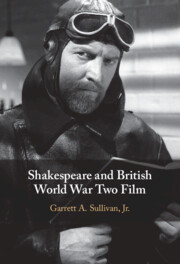Book contents
- Shakespeare and British World War Two Film
- Shakespeare and British World War Two Film
- Copyright page
- Dedication
- Contents
- Figures
- Acknowledgments
- Introduction
- Chapter 1 “Hamlet’s a Loser, Leslie”
- Chapter 2 “What We All Have in Common”
- Chapter 3 The Black-White Gentleman
- Chapter 4 “Bottom’s Not a Gangster!”
- Coda Two Cities Films and “the Spirit of Britain”
- Index
Chapter 4 - “Bottom’s Not a Gangster!”
A Matter of Life and Death, A Midsummer Night’s Dream and Postwar Anglo-American Relations
Published online by Cambridge University Press: 24 March 2022
- Shakespeare and British World War Two Film
- Shakespeare and British World War Two Film
- Copyright page
- Dedication
- Contents
- Figures
- Acknowledgments
- Introduction
- Chapter 1 “Hamlet’s a Loser, Leslie”
- Chapter 2 “What We All Have in Common”
- Chapter 3 The Black-White Gentleman
- Chapter 4 “Bottom’s Not a Gangster!”
- Coda Two Cities Films and “the Spirit of Britain”
- Index
Summary
In Michael Powell and Emeric Pressburger’s A Matter of Life and Death, Shakespeare plays contradictory roles. On the one hand, he emblematizes the cultural inheritance Britain shares with the United States; on the other, he serves as the vehicle by which to assert British artistic superiority. The tensions between these roles is explored in a scene in which American service men and women, under the direction of a British vicar, rehearse episodes from A Midsummer Night’s Dream. Through this scene, Powell and Pressburger both mock American movies and betray their anxieties about the British film industry’s postwar future. At the same time, they make the case for the imaginative primacy of British cinema—and, indeed, of their own films—over Hollywood. The chapter concludes by considering links between A Matter of Life and Death and Powell’s unrealized adaptation of The Tempest, in which Prospero stands in for the filmmaker in exile.
Keywords
- Type
- Chapter
- Information
- Shakespeare and British World War Two Film , pp. 136 - 170Publisher: Cambridge University PressPrint publication year: 2022

